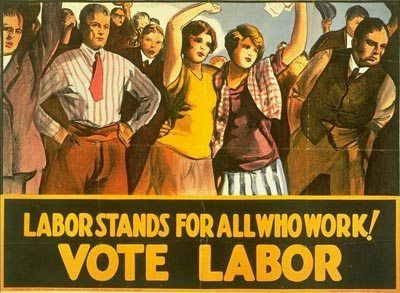In his fifth chapter of No Bosses, Albert discusses who should receive what from the total goods and services a society produces. He frames this total as “society’s pie.” The author considers various (used and proposed) means for this distribution according to how they (do or would) promote or undermine the values we discussed in our first post of this series. He first argues against property-based income, as it …
…causes ceaseless class conflict over property-induced differences in wealth and power. It demolishes diversity by homogenizing each contending class. It subverts sustainability by giving centralized power an interest in exploiting nature to ceaselessly accumulate profits.
He next argues against income based on power itself (the dynamic behind a market-based economy.) Under this system, people “get more income if they are strong enough to take more. They … get less income if they are sufficiently weak to be given less.” The author gives various examples of where such power in markets usually comes, such as, from property, from a monopoly over information or skills, and from being white in a white-dominated society.
No Bosses argues against another form of power, distribution based on what each person contributes through her labor to “society’s pie,” asking what might cause differences in individuals’ ability to produce. The author points out that such a method would “reward only your luck in the genetic, equipment, workmate, or assigned product lottery.” He asks, “Is rewarding luck fair? Or does rewarding luck subvert fairness and our other values similarly to how rewarding property or bargaining power subverts them?”
Albert repeats the principle I gave in the first entry to this series, that under his system, “We get income … for the duration, intensity, and onerousness of our socially-valued work.” In this way, “the greater loss I endure due to my particular efforts [w]ould be offset by my getting more income for” them. As to the last part of his formulation, that the product of our remunerated work be socially valued, he refers to the idea of the Commons, adding to the natural and historical kinds, “what we might call a human commons in society … the accumulation of skills, knowledge, and talents held by humans.” What would most benefit society is what makes the best use of these commons.
The author next turns to how to implement this principle, though acknowledging that “what counts as socially-valued work has to wait as the answer depends on the economy’s method of allocation, a subject taken up in our next two chapters.” This chapter deals first with measuring the three endurance factors: “counting the hours a person works would be easy … Likewise, instances of significant difference in job onerousness would be modest, though perhaps this would arise with dealing with crises that arise.” For intensity, the author notes that “the precise methodology for allotting income inside workplaces among their workforce need not be the same from workplace to workplace.” He offers a general approach based on an “evaluation report” each worker could get, either …
…from their team or from their whole workplace or from just a committee established for the purpose where the report indicates the income they should receive to be used for consumption expenditures. This evaluation report might, for example indicate hours worked, intensity of work, and onerousness of conditions, yielding an overall “effort rating” in the form of a percentage multiplier. If the rating was one, the person’s remuneration would be the social average for the workplace. If that rating was 1.1, it would be a tenth more, if it was 0.9, it would be a tenth less. …
The book goes into much more detail here, but I think the foregoing gives a good idea of what it suggests. I’ll just record a couple qualifications that Albert makes: First, that “however different various [scoring] procedures might be, they could not lead to extreme income differentials since there could only be so much variation in [the principle’s three factors] in any event”; second, that his approach only covers particular workplaces in the entire system – he leaves many questions open for later parts of the book.
The chapter then deals with issues of incentive. The author first counters another Thatcherite argument – “that it wouldn’t be [a gain] to create an equitable society in which, however, no one was motivated to do any creative work that requires a lot of training, or for that matter, to be productive at anything.” He answers …
… that with equitable remuneration the economy’s incentives are just what they ought to be. Income earned for [the principle’s three factors] provides an incentive to work longer (but not so long that the loss of leisure outweighs the gain on income), harder (but not so hard that the losses due to exertion outweigh the gain in income), and, when need be, to complete really onerous tasks that prove necessary outside of balanced job complexes (but not when the pain due to the onerousness exceeds the benefits due to the gain in income).
In fact, No Bosses points out that motivations such as property and power will lead to those who gain these advantages to exploit others ever more aggressively, whereas payments for innate talents “have no useful incentive effect.” As far as equitable income reducing the desire for more creative or professional work, such as medicine or management, Albert asks whether the reader or anyone with a chance at free education for such jobs would prefer a rote and repetitive job, observing that “every student group, including those who are pre-med,” he has asked “would only switch if survival was in question.”
To the objection that any remuneration for effort might sully the motivation of altruism, No Bosses points out that those who refuse to take “more pay for longer hours in our current society … [usually make] way above average rates of payment” and feel uncomfortable taking “more for work they eagerly do.” In any case, the author sees no downside to a worker’s refusal to take extra remuneration.
The last motivation issue is that some who prefer more goods than average could “drift toward a longer work day, toward more intense labor, and toward worse working conditions.” Although acknowledging that this is possible, Albert asserts that that mainstream economists point out that “people are highly likely to want more leisure … rather than more stuff.” However, if I prefer the latter, in the proposed system, the “extra income would be warranted by my actions and if properly agreed and organized would have no ill effects on anyone else’s situation,” nor would this type of society encourage me to “drive myself to dissolution in a mad pursuit of additional income.”
The last objection the author covers in this chapter is encapsulated by Karl Marx’s famous slogan, “from each according to his ability, to each according to his needs.” After considering the possible meanings of this slogan, Albert concludes,
…it assumes a mechanism which conveys to each worker and consumer personal and system-wide information that allows them to make responsible choices without imposing class divisions, violating the ecology, enriching the few, or unnecessarily hurting anyone. Of course, the irony is that what can provide that, and was literally conceived to provide that, is …
…participatory planning, including the principle he has been expounding in this chapter. He notes various ways in which his proposal can advance solidarity, summarizing – “It will turn out to be that we cooperatively negotiate outcomes to enjoy gains and endure losses together, even as we also seek work and consumption that is best suited to our personal fulfillment.” He then promises to describe an “allocation mechanism, like our other proposed defining economic features, to produce solidarity and to make typical kinds of anti-sociality literally irrational while abetting equity and delivering collective self-management.”
The chapter ends by discussing how the new economy would handle free consumption. The author notes that although “individuals would not be expected to reduce their requests for other consumption activities because they consume free goods, … the average individual consumption per person will drop when society as a whole consumes more free goods,” since the potential used to produce them reduces the production of other items. He writes that, due to the aforementioned values upon which a participatory society is built, “particular consumption activities such as health care, education, or public parks may be deemed free to all.” Guided by such values, the benefits of these activities are either “generalized, or [the costs are] universally apportioned rather than penalizing those in need.” On the same principle, a participatory society would provide for those who can’t work “for reasons of health, age, or whatever else may be the case.” Ultimately, “what items should be on the free list would be debated, presumably in consumer federations, but medical care is an obvious example.” Likewise, relevant consumer counsels would address particular requests, submitted with justification for the needed extra consumption, case by case, most likely spreading the costs over the population of the approving council .
Our next entry will cover the allocation chapters. Since this portion is long, this may take a bit of time.








